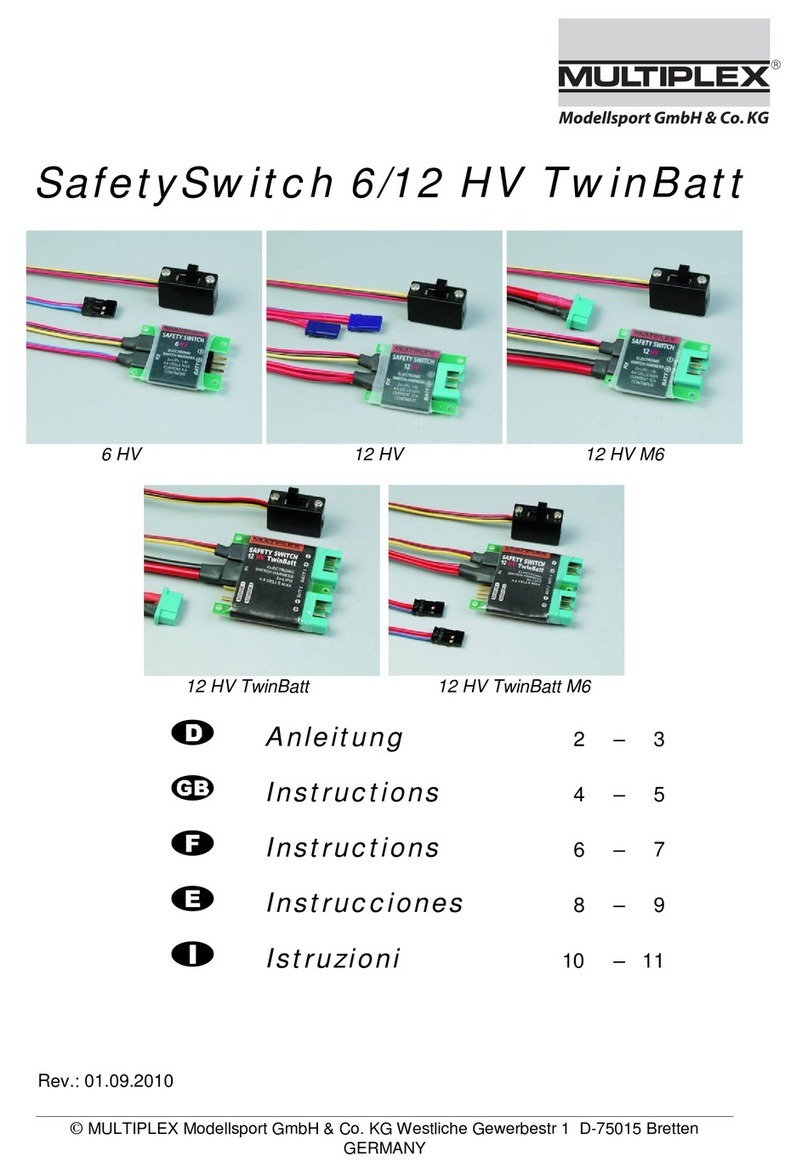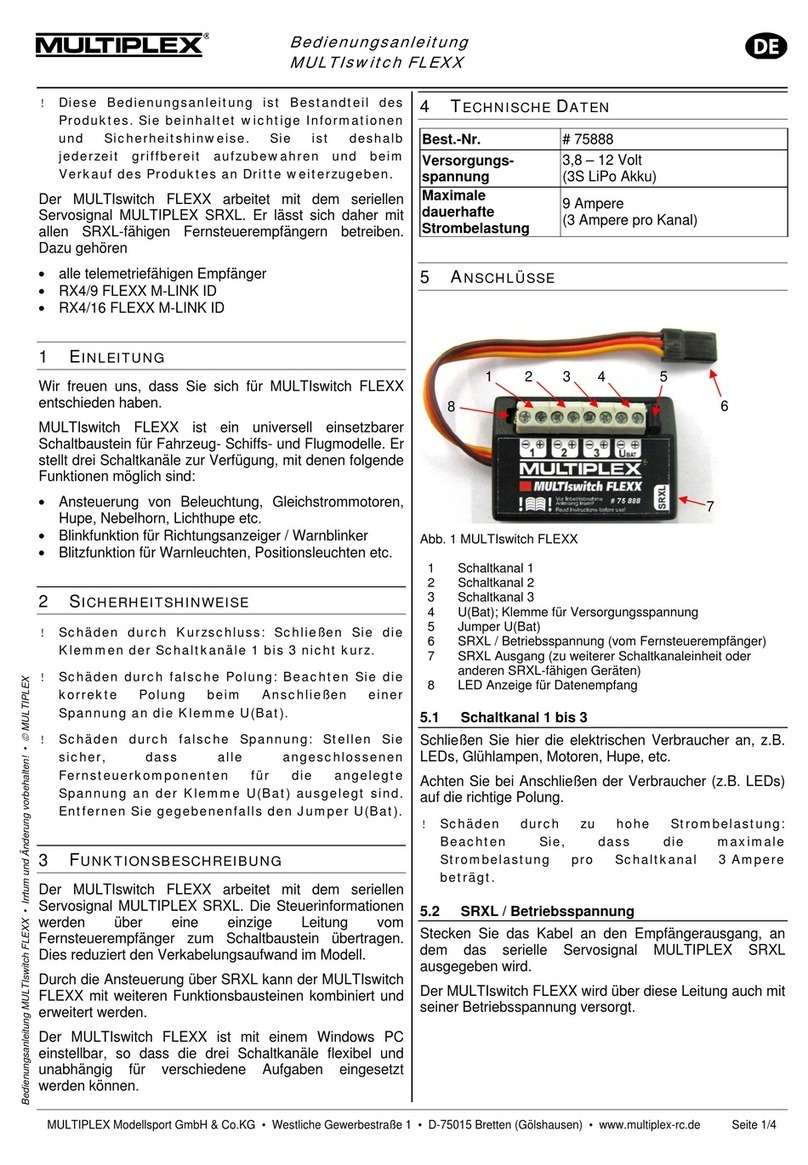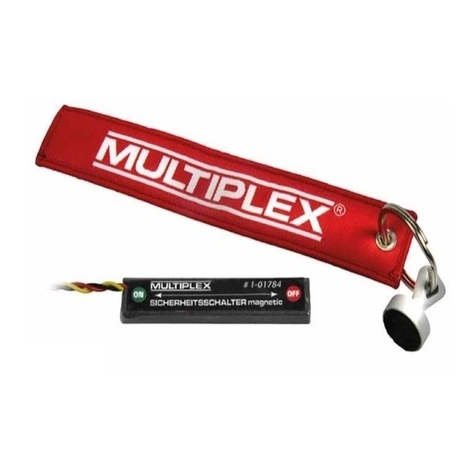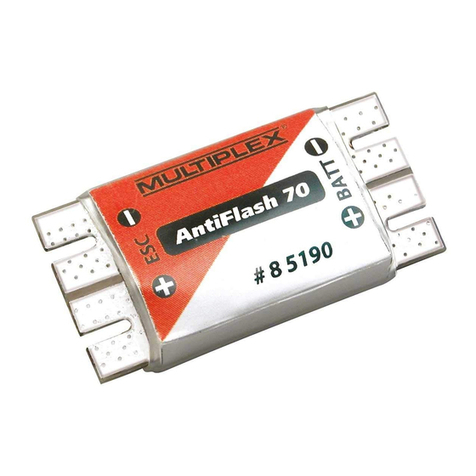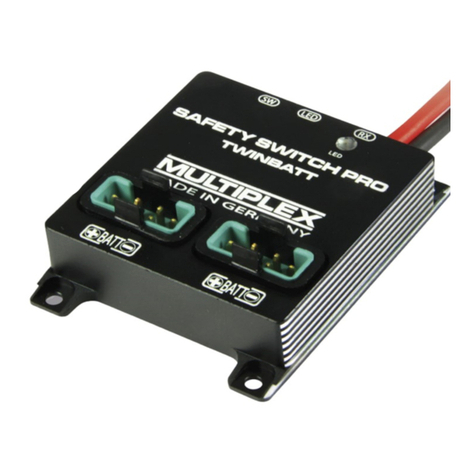
Bedienungsanleitung
SAFETY-SWITCH LiPo und SAFETY-SWITCH LiPo TwinBatt
MULTIPLEX Modellsport GmbH & Co.KG • Westliche Gewerbestraße 1 • D-75015 Bretten (Gölshausen) • www.multiplex-rc.de Seite 5/6
Anleitung SAFETY-SWITCH LiPo und SAFETY-SWITCH LiPo TwinBatt # 82 5518 (08-05-05/MIWA) •Irrtum und Änderung vorbehalten! •
MULTIPLEX
Drücken Sie dazu die SET-Taste und halten Sie diese Taste
gedrückt:
a) Zusätzlich zur linken und rechten LED beginnt nun auch
die mittlere LED zu leuchten (in roter Farbe)
b) Nach weiteren zirka 5 Sekunden gehen alle LED´s kurz
aus
c) Anschließend blinkt die mittlere LED einmal rot
Lassen Sie die SET-Taste jetzt los, ist der eingestellte
Akkutyp LiPo
Wenn Sie den Taster weiterhin gedrückt halten, blinkt die
mittlere LED zweimal rot
Lassen Sie die SET-Taste erst jetzt los, ist die Span-
nungsüberwachung auf einen 5 zelligen NiXX-Akku
eingestellt
9.2.3 Minimalwertspeicher bei SAFETY-SWITCH LiPo TwinBatt
Für eine noch bessere Überwachung der Spannungsversorger
wurde im SAFETY-SWITCH LiPo TwinBatt zusätzlich je ein
Minimalwertspeicher (low voltage memory) implementiert.
Dieser Minimalwertspeicher zeichnet eventuelle Spannungsein-
brüche eines oder beider Akkus während des letzten Fluges auf.
Abrufen des Minimalwertspeichers nach dem Flug:
Drücken Sie vor dem Ausschalten gleichzeitig auf die beiden
Sensortasten I und II (Sensortasten gedrückt halten).
Die jetzt angezeigten Farben der linken und rechten LED signa-
lisieren Ihnen die minimalen Spannungswerte je Akku seit dem
letzten Einschalten.
Hinweis
Beim Ausschalten der Stromversorgung werden die beiden
Speicher zurückgesetzt (RESET).
Beim erneuten Einschalten beginnt die Aufzeichnung von Neu-
em.
9.2.4 Akkuweichenfunktion bei SAFETY-SWITCH LiPo TwinBatt
Eine integrierte Akkuweiche ermöglicht beim SAFETY-SWITCH
LiPo TwinBatt den Betrieb mit 2 Empfängerakkus für noch
mehr Sicherheit.
Bei Ausfall eines Akkus übernimmt der zweite Akku die Strom-
versorgung der Empfangsanlage. Die gesamte Stromlast der
Empfangsanlage im Modell verteilt sich auf 2 Akkus.
Das System ist zweifach aufgebaut, d.h. jeder der beiden Strom-
versorgungspfade enthält einen eigenen elektronischen Schal-
ter, je einen separaten Spannungsregler und für beide Akkus
getrennt eine Spannungsüberwachung.
Somit können Sie einen defekten oder sich am Ende seiner
Lebensdauer befindlichen Empfängerakku leicht identifizieren
und rechtzeitig ersetzen.
10. S
ICHERHEITS
-„H
OLD
“-M
ODUS
Kommt es während der eingeschalteten Phase zu Unregelmä-
ßigkeiten, Überhitzung, Bauteileausfall, Wacklern im Anschluss-
kabel oder Akku, bleiben SAFETY-SWITCH LiPo und SAFETY-
SWITCH LiPo TwinBatt immer eingeschaltet. Auch ein nicht
korrekt durchgeführter Ausschaltvorgang kann das Programm
dazu veranlassen, in den Sicherheits-„Hold“-Modus zu gehen.
Ein Ausschalten ist dann mit dem Taster nicht mehr möglich.
Bitte trennen Sie in diesem Falle die angeschlossene Strom-
quelle vom Schalterkabel für mindestens 30 Sekunden. Nach
erneutem Anstecken wird das Programm neu gestartet und die
Schaltfunktion ist wieder freigegeben.
Bitte überprüfen Sie auch Ihre Akkus, sollte sich der Vorgang
öfters wiederholen.
11. E
MPFÄNGERAKKU BEI LÄNGERER
N
ICHTBENUTZUNG ABSTECKEN
Ist am Schalterkabel im ausgeschalteten Zustand ein Akku an-
gesteckt, ist eine sogenannte „stand-by“-Schaltung aktiv.
Der Ruhestrom von ca. 5,0 µA (je Akku) ist allerdings geringer
als die Selbstentladung Ihres Akkus.
Wir empfehlen Ihnen, den/die Akku(s) vom SAFETY-SWITCH
LiPo / SAFETY-SWITCH LiPo TwinBatt abzustecken, wenn
Sie das Modell über einen längeren Zeitraum nicht benutzen.
12. V
ERWENDUNG VON
L
I
I
O
-
UND
L
I
F
E
-A
KKUS
Sollen an den Schalterkabeln zweizellige LiIo-Akkus (LiIo =
Lithium Ionen) mit einer Nennspannung von 3,6 V pro Zelle
angeschlossen werden, ist die Einstellung der Schalterkabel auf
den Akkutyp „LiPo“ beizubehalten (Werkseinstellung) (8.2.2
bzw. 9.2.2).
Die Verwendung zweizelliger LiFe-Akkus (LiFe = Lithium Ferrit)
mit einer Nennspannung von 3,3 V pro Zelle ist möglich. Dabei
ist die Einstellung der Schalterkabel auf den Akkutyp „NiXX“ zu
ändern (8.2.2 bzw. 9.2.2).
13. CE-K
ONFORMITÄTSERKLÄRUNG
Die Bewertung des Gerätes erfolgte nach europäisch
harmonisierten Richtlinien.
Sie besitzen daher ein Produkt, das hinsichtlich der Konstruktion
die Schutzziele der Europäischen Gemeinschaft zum sicheren
Betrieb der Geräte erfüllt.
Die Konformitätserklärung des Gerätes kann bei der
MULTIPLEX Modellsport GmbH & Co.KG angefordert werden.
14. G
EWÄHRLEISTUNG
/
H
AFTUNGSAUSSCHLUSS
Die Firma MULTIPLEX Modellsport GmbH & Co.KG übernimmt
keinerlei Haftung für Verluste, Schäden oder Kosten, die sich
aus fehlerhafter Verwendung und Betrieb ergeben oder in ir-
gendeiner Weise damit zusammenhängen. Soweit gesetzlich
zulässig, ist die Verpflichtung der Firma MULTIPLEX Mo-
dellsport GmbH & Co.KG zur Leistung von Schadenersatz,
gleich aus welchem Rechtsgrund, begrenzt auf den Rech-
nungswert der an dem schadenstiftenden Ereignis unmittelbar
beteiligten Warenmenge der Firma MULTIPLEX Modellsport
GmbH & Co.KG. Dies gilt nicht, soweit die MULTIPLEX
Modelldellsport GmbH & Co.KG nach zwingenden gesetzlichen
Vorschriften wegen Vorsatzes oder grober Fahrlässigkeit unbe-
schränkt haftet.
Für unsere Produkte leisten wir entsprechend den derzeit gel-
tenden gesetzlichen Bestimmungen Gewähr. Wenden Sie sich
mit Gewährleistungsfällen an den Fachhändler, bei dem Sie das
Produkt erworben haben.
Von der Gewährleistung ausgeschlossen sind Fehlfunktionen,
die verursacht wurden durch:
- unsachgemäßen Betrieb
- falsche, nicht oder verspätet, oder nicht von einer autorisierten
Stelle durchgeführte Wartung
- falsche Anschlüsse
- Verwendung von nicht originalem MULTIPLEX-Zubehör
- Veränderungen/Reparaturen, die nicht von MULTIPLEX oder
einer MULTIPLEX-Service-Stelle ausgeführt wurden
- versehentliche oder absichtliche Beschädigungen
- Defekte, die sich aus der normalen Abnutzung ergeben
- Betrieb außerhalb der technischen Spezifikationen
- oder im Zusammenhang mit Komponenten anderer Hersteller












